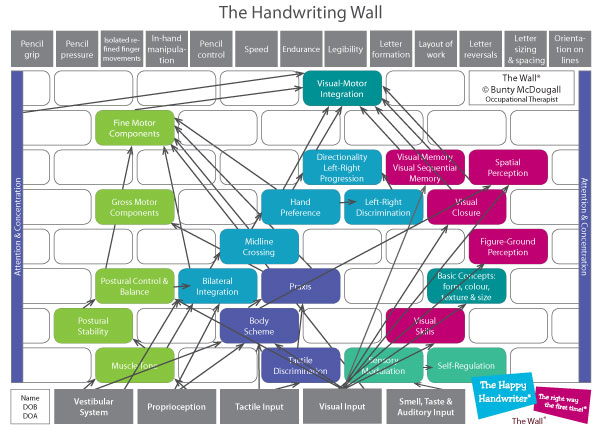
Are handwriting skills critical to your child’s success. In this digital age, children are swiping and tapping on screens before they are even able to hold a spoon, or put on their shoes independently. What exactly, if anything, are our children losing out on?
As a pediatric occupational therapist, I have had innumerable referrals for improving handwriting over the years. Handwriting is such a complex task, that upon task analysis, there are many underlying components that a child needs to develop, prior to performing this arduous task. So, the Occupational Therapy assessment following a handwriting referral often reveal quite diverse results.

The handwriting wall above, was developed by a South African Occupational Therapist (Bunty McDougall) and is used to explain how the foundational sensory input blocks (at the bottom) feed into, and facilitate the development of the different components or bricks at the top.
The green bricks have foundational components in the vestibular and proprioceptive systems which have a direct impact on muscle tone and postural stability, and this is essential for children to hold themselves upright in their seats and position their bodies for handwriting. Postural control and adequate muscle tone are necessary for stability in order for the fingers and hands to complete the handwriting task. Children who have challenges with postural tone may slouch over the table, and at times may rest their head on their hands or on the desk. This can greatly affect written work, as correct seating posture is essential for ensuring that handwriting mechanics are correct.
Self-Regulation and Sensory Modulation are so frequently discussed and should never be minimalized as children need the ability to screen out irrelevant stimuli and remain seated to maintain an optimum state of regulation when handwriting. These are located very much lower in the wall and highlight the importance of sensory integration therapy for handwriting.
The development of praxis (motor planning) finds its foundations in the tactile and proprioceptive systems. Motor planning refers to planning and executing unfamiliar motor patterns, which is critical for letter formation. Often, therapists will work on motor planning in gross motor areas which contributes to better handwriting.
Hand preference or hand dominance is also essential for handwriting, and the foundations for this are in the vestibular and proprioceptive systems. The light blue block sequence above illustrates that children first begin to use both sides of their body in a coordinated manner (bilateral integration) and further develop midline crossing and then hand dominance.
Vision and visual perception are critical for handwriting, and these are outlined in the pink block sequence. These skills develop early in a child’s life and are refined as children mature. Visual perception is as equally essential to handwriting as motor skills, as children need to visually analyse how letters are constructed, and how to visually space and orient the letters before writing them.
Considering then, that there are so many complex modalities, is it worth the effort to have occupational therapy to improve handwriting for children with impairments, or should we opt to teach children to use a keyboard?
My advice to any parent is to consult with your occupational therapist before making this decision. However, I would like to explore both sides of this issue below.
The case for handwriting
The case for handwriting even in this technologically-driven age can be summarized as follows:
- Handwriting can improve a child’s level of literacy. A study conducted by Indiana University showed that handwriting activated three different areas of the brain. These three areas (the inferior frontal gyrus, the left fusiform gyrus, and the posterior parietal cortex) are actually essential for literacy. Brain imaging revealed that activation of these regions is different for children who have challenges with handwriting. (James KH, Engelhardt L. The effects of handwriting experience on functional brain development in pre-literate children. Trends Neurosci Educ. 2012;1(1):32-42. doi:10.1016/j.tine.2012.08.001)
- Handwriting improves attention and cognition. Research has demonstrated that children who follow the traditional handwriting teaching method have cognitive benefits such as self-regulation, attention sustenance, working memory activation, better transcription of thought-to-script, and overall quality of text production. (Bara & Gentaz, 2011; Berninger et al., 2009a, 2009b; Connelly et al., 2007; Cunningham & Stanovich, 1990; Longcamp et al., 2005; Smoker et al., 2009; Velay & Longcamp, 2010).
- Handwriting is less restrictive. Authors have often argued that they think more freely when brainstorming using handwriting, as they are able to write things down, link ideas using lines, circle important point and add side notes. While most people argue that this can be done on a computer, the distractions of using a computer are always present and may restrict the creative flow of the author.
- Handwriting supports learning the alphabet. The Iowa Reading Research Centre reported that handwriting skills help children learn the letters of the alphabet better, because they are allowed to understand the shape, spatial orientation and structure of the letters.
- Additionally, the American Academy of Pediatrics (AAP) explains that children who write quickly and legibly are likely to express their thoughts more effectively.
The case for keyboarding
- Children should both write and type. Virginia Berninger is a professor of educational psychology at the University of Washington and has undertaken extensive research which suggests that children should become hybrid writers, – “manuscript (print) first for reading — it transfers to better word recognition — then cursive for spelling and for composing. Then, starting in late elementary school, touch-typing.” A child once said, “For children who take a longer time to form letters by hand, typing allows for creative expression that keeps pace with the child’s thoughts and imagination.”
- Keyboarding is an assistive technology. Researchers also suggest that keyboarding may be a potential alternative writing tool for students with handwriting difficulties.
Advice to parents:
- Seek the advice of your child’s teacher and occupational therapist I you are concerned about handwriting. As described above, a child may have challenges with handwriting due to underlying sensory motor difficulties. Once these challenges have been resolved, handwriting may be an easier task to work on.
In other cases, children may have moderate to severe impairments which necessitate the need for using a keyboard. - There is a place for both handwriting and keyboarding. Once a child has been assessed, there may be a need for using both traditional handwriting and a keyboarding.
Should you require additional information on supporting your child’s development in either handwriting or keyboarding skills please contact us.
Sources:
- American Journal of Occupational Therapy, March/April 2004, Vol. 58, 193-201. Predicting Occupational Performance: Handwriting Versus Keyboarding Fabia Preminger; Patrice L. (Tamar) Weiss; Naomi Weintraub
- Berninger, V. (2009). Highlights of programmatic, interdisciplinary research on writing. Learning Disabilities. Research and Practice, 24, 68-79
- https://www.aota.org/
- Karavanidou, Eleni. (2017). Is Handwriting Relevant in the Digital Era?. Antistasis. 7. 153-164.
- https://buntys-wall.com/





